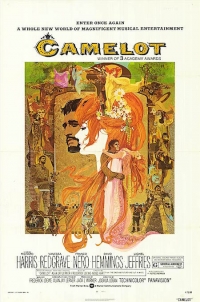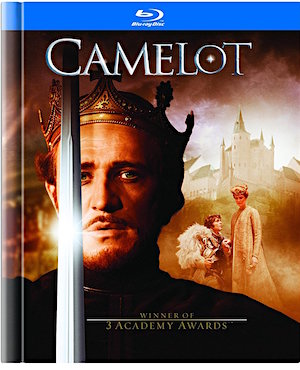“It’s clear in retrospect that Camelot began the extinction process of old school Broadway musicals extravagantly transferred to the screen.” — Matthew Kennedy, author of Roadshow! The Fall of Film Musicals in the 1960s
The Digital Bits and History, Legacy & Showmanship are pleased to present this retrospective commemorating the golden anniversary of the release of Camelot, the Oscar-winning cinematic interpretation of the King Arthur legend and the Lerner and Loewe stage musical which starred Richard Harris (Cromwell, Unforgiven) as King Arthur and Vanessa Redgrave (Blow-up, Julia) as Guenevere.
Camelot — directed by Joshua Logan (South Pacific, Paint Your Wagon) and which featured Franco Nero, David Hemmings and Lionel Jeffries in supporting roles — opened 50 years ago this past autumn. For the occasion, The Bits features an historical reference listing of the film’s major-market roadshow engagements and a Q&A with film historian Matthew Kennedy, who discusses the film’s virtues, shortcomings and legacy. [Read on here...]

THE ROADSHOW ENGAGEMENTS
What follows, for historical record and nostalgia, is a chronological reference listing of the North American first run “hard ticket” roadshow engagements of Camelot. These were special long-running, showcase presentations in major cities prior to the film being exhibited as a general release, and they featured advanced admission pricing, reserved seating, an overture/intermission/entr’acte/exit music, and an average of only ten scheduled screenings per week. Souvenir program booklet were sold, as well.
Out of the hundreds of films released during 1967, Camelot was among only eight that were given deluxe roadshow treatment.
Many of the roadshow presentations of Camelot were, as the promotional material proudly boasted, presented in “breathtaking 70mm” (which were blown up from anamorphic 35mm) and offered a superior projection and sound experience. All of the film’s roadshow presentations are believed to have been presented with stereophonic sound (4-track for 35mm and 6-track for 70mm).
Note that this is not a complete listing. Instead, the primary objective was to focus on the top markets in North America and also provide as sprinkling of secondary market entries to give a sense of the types of locales involved in the roadshow release. Also understand the engagements cited here represent only a fraction of the thousands of total bookings throughout the many cycles of distribution over the course of the film’s release. As well, this work does not include any general, international or re-release engagements. The duration of the cited engagements (measured in weeks) is provided for some of the entries to give the reader a sense of the movie’s popularity.
The film’s anniversary offers an opportunity to namedrop some famous and once-glorious cinemas, to provide some nostalgia for those who saw the film during this phase of its original release, and to reflect on how the film industry has evolved the manner in which event and prestige films are exhibited.
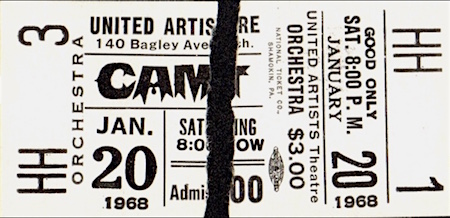
Opening date YYYY-MM-DD … City — Cinema (duration in weeks)
- 1967-10-25 … New York, NY — Warner (34)
- 1967-10-27 … Chicago, IL — Bismarck (47)
- 1967-10-30 … Boston, MA — Music Hall (benefit premiere only)
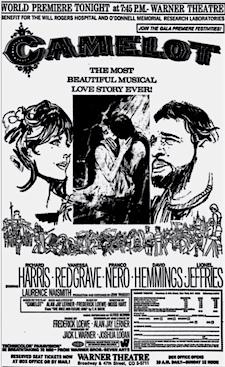 1967-11-01 … Boston, MA — Saxon (32)
1967-11-01 … Boston, MA — Saxon (32)- 1967-11-01 … Detroit, MI — United Artists (32)
- 1967-11-01 … Los Angeles, CA — Cinerama Dome (51)
- 1967-11-01 … San Francisco, CA — Coronet (39)
- 1967-11-02 … Edmonton, AB — Varscona (18) [35mm]
- 1967-11-02 … Montreal, QC — Westmount (15)
- 1967-11-02 … Vancouver, BC — Stanley (18)
- 1967-11-02 … Winnipeg, MB — Gaiety (18) [35mm]
- 1967-11-07 … Cleveland, OH — Colony (20)
- 1967-11-07 … Miami (Miami Beach), FL — Lincoln (33)
- 1967-11-08 … Cincinnati, OH — Kenwood (25)
- 1967-11-08 … Dallas, TX — Inwood (23)
- 1967-11-08 … Honolulu, HI — Kuhio (21)
- 1967-11-08 … Houston, TX — Alabama
- 1967-11-08 … Minneapolis, MN — Academy (49)
- 1967-11-08 … Oklahoma City, OK — Tower (24)
- 1967-11-08 … Pittsburgh, PA — Squirrel Hill (24)
- 1967-11-08 … Washington, DC — Warner (31)
- 1967-11-09 … Philadelphia, PA — Stanley (33)
- 1967-11-14 … Kansas City, MO — Capri (36)
- 1967-11-14 … Seattle, WA — Music Box (25)
- 1967-11-15 … Atlanta, GA — Martin Cinerama (28)
- 1967-11-15 … Omaha, NE — Cooper 70 (21)
- 1967-11-15 … Ottawa, ON — Nelson (14)
- 1967-11-15 … Portland, OR — Paramount (29)
- 1967-11-16 … New Orleans, LA — Saenger-Orleans (18)
- 1967-11-22 … St. Petersburg, FL — Center (27)
- 1967-11-22 … San Antonio, TX — Wonder (16)
- 1967-12-20 … Albany, NY — Madison (12+)
- 1967-12-20 … Baltimore, MD — New (18)
- 1967-12-20 … Hartford (Wethersfield), CT — Cine Webb (18)
- 1967-12-20 … Milwaukee, WI — Towne (31)
- 1967-12-20 … Rochester, NY — Waring (19) [35mm]
- 1967-12-20 … St. Louis (Richmond Heights), MO — Esquire (23)
- 1967-12-20 … Syracuse, NY — Eckel (14)
- 1967-12-20 … Toronto, ON — University (22)
- 1967-12-21 … Buffalo, NY — Teck (15)
- 1967-12-21 … Calgary, AB — Chinook (13)
- 1967-12-21 … Indianapolis, IN — Circle (23)
- 1967-12-21 … Phoenix (Scottsdale), AZ — Camelback Mall (23) [35mm]
- 1967-12-21 … Providence, RI — Elmwood
- 1967-12-21 … San Diego, CA — Cinerama (41)
- 1967-12-21 … Tucson, AZ — El Dorado (13) [35mm]
- 1967-12-22 … Charlotte, NC — Park Terrace
- 1967-12-22 … Columbus, OH — Cinestage
- 1967-12-22 … Des Moines, IA — Ingersoll (23) [35mm]
- 1967-12-22 … Memphis, TN — Paramount (13)
- 1967-12-22 … Portland, ME — Empire [35mm]
- 1968-01-10 … Las Vegas, NV — Cinerama (9)
- 1968-01-17 … Springfield (West Springfield), MA — Showcase 3 (15)
- 1968-01-26 … Palm Beach (West Palm Beach), FL — Florida (7) [35mm]
- 1968-01-31 … Louisville, KY — Showcase 2 (14) [35mm]
- 1968-02-07 … Dayton (Trotwood), OH — Salem Mall (12+)
- 1968-02-07 … Fresno, CA — Hardy [35mm]
- 1968-02-07 … Newark (Upper Montclair), NJ — Bellevue (20)
- 1968-02-07 … Norfolk, VA — Lee [35mm]
- 1968-02-07 … Wichita, KS — Uptown (14)
- 1968-02-14 … Denver, CO — Aladdin (40)
- 1968-02-14 … Harrisburg, PA — Eric
- 1968-02-14 … Richmond, VA — Willow Lawn (19)
- 1968-02-14 … Salt Lake City, UT — Centre (40)
- 1968-02-27 … Toledo, OH — Showcase 3 (16)
- 1968-03-13 … El Paso, TX — Pershing (7) [35mm]
- 1968-04-03 … Akron, OH — Village (15) [35mm]
- 1968-04-03 … Asbury Park, NJ — St. James (12)
- 1968-04-03 … Green Bay, WI — West (21) [35mm]
- 1968-04-03 … Lawrence, MA — Showcase 2 (11)
- 1968-04-03 … Madison, WI — Hilldale (18) [35mm]
- 1968-04-03 … Oakland, CA — Grand Lake (16) [35mm]
- 1968-04-10 … Binghamton, NY — Capri (11)
- 1968-04-10 … Palm Springs, CA — Camelot (6)
- 1968-04-11 … Lubbock, TX — Cinema West (7) [35mm]
- 1968-04-12 … Cedar Rapids, IA — Times 70 (10)
- 1968-04-12 … Dubuque, IA — Strand (11) [35mm]
- 1968-04-17 … New Haven, CT — Whalley (23)
- 1968-04-?? … Atlantic City, NJ — ?
- 1968-05-28 … San Jose, CA — Century 23 (34)
- 1968-05-31 … Orlando, FL — Beacham (10)
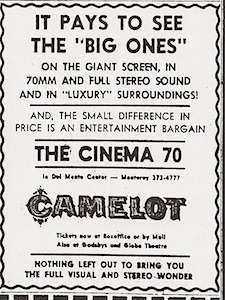 1968-06-07 … Evansville, IN — Ross (8) [35mm]
1968-06-07 … Evansville, IN — Ross (8) [35mm]- 1968-06-12 … Colorado Springs, CO — Cinema 70 (6)
- 1968-06-12 … Greenville, SC — Astro (8)
- 1968-06-12 … Raleigh, NC — Colony (10) [35mm]
- 1968-06-12 … Shreveport, LA — Strand (6) [35mm]
- 1968-06-13 … Nashville, TN — Green Hills (12) [35mm]
- 1968-06-18 … Sacramento, CA — Century 22 (26)
- 1968-06-19 … Albuquerque, NM — Lobo (12) [35mm]
- 1968-06-19 … Austin, TX — Americana (8)
- 1968-06-19 … Lynbrook, NY — Lynbrook
- 1968-06-19 … Reading, PA — Shillington (12) [35mm]
- 1968-06-26 … Burlington, VT — State (8) [35mm]
- 1968-06-26 … Reno, NV — Century 21 (7)
- 1968-06-27 … Greensboro, NC — Terrace (7)
- 1968-06-27 … Youngstown, OH — Paramount (13)
- 1968-06-28 … Columbia, SC — Richland Mall (7)
- 1968-06-28 … Springfield, IL — Frisina (5) [35mm]
- 1968-06-?? … Birmingham, AL — Ritz
- 1968-07-03 … Monterey, CA — Cinema 70 (15)
- 1968-07-03 … Pensacola, FL — Rex (5) [35mm]
- 1968-07-03 … Winston-Salem, NC — Winston [35mm]
- 1968-07-18 … Corpus Christi, TX — Deux Cine (6) [35mm]
- 1968-07-19 … Jacksonville, FL — Center (6) [35mm]
- 1968-08-07 … Durham, NC — Center
- 1968-08-14 … Amarillo, TX — Esquire (6) [35mm]
- 1968-08-14 … Montgomery, AL — Capri (6) [35mm]
- 1968-08-21 … Spartanburg, SC — Palmetto (4) [35mm]
- 1968-09-11 … Pleasant Hill, CA — Century 21 (9)
- 1968-11-21 … Odessa, TX — Grandview (4) [35mm]
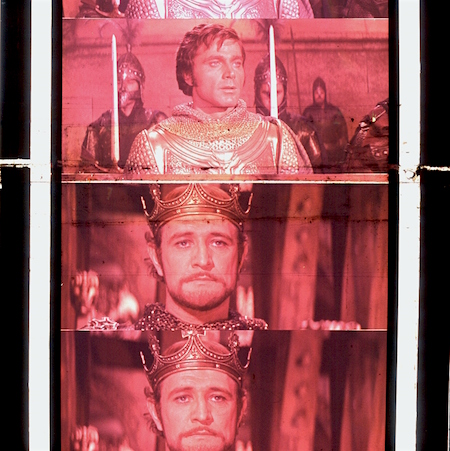
THE Q&A
Matthew Kennedy is a writer, film historian, and anthropologist living in Oakland. He is the author of Roadshow! The Fall of Film Musicals in the 1960s (Oxford University Press, 2014), Joan Blondell: A Life between Takes (University Press of Mississippi, 2007), Edmund Goulding’s Dark Victory: Hollywood’s Genius Bad Boy (University of Wisconsin Press, 2004), and Marie Dressler: A Biography (McFarland, 1999). His articles have appeared in the program books of the San Francisco Silent Film Festival and Turner Classic Movies Classic Film Festival. He is film and book critic for the respected Bright Lights Film Journal and has hosted retrospectives based on his books at the Pacific Film Archive, UCLA Film Archive, and the Museum of Modern Art.
Michael Coate (The Digital Bits): How do you think Camelot should be remembered on its 50th anniversary?
Matthew Kennedy: If for no other reason, Camelot should be remembered as a kind of elegy for musical films, and political idealism and innocence as reflected in the Kennedy presidency. Soon after Kennedy’s assassination, Jacqueline Kennedy told a reporter that her husband often listened to the Camelot Broadway album, and loved the lyric:
Don’t let it be forgot
That once there was a spot
For one brief shining moment
That was known as Camelot.
The screen version was released in 1967, four years after his death, but it was made with an awareness of that association. A vague idealism for a just and even utopian society courses through the film, informed by the Kennedy connection.
Coate: What is your opinion of Camelot and when did you first see it?
Kennedy: Camelot is a prime example of the problem with Hollywood “wisdom” in the late 1960s. Since My Fair Lady and The Sound of Music were such colossal hits, it only stands to reason that another big budgeted adaptation of a recent Broadway musical would perform similarly at the box office. But it didn’t happen as Jack Warner envisioned. Camelot, its story dominated by a tale of infidelity, doesn’t have the widespread appeal of Lady or Music. It’s long and miscast, though intermittently scrumptious to the eyes and ears. I find Camelot interesting in light of its timing — showing up in the marketplace in 1967 alongside The Graduate and Bonnie and Clyde. It seriously lacked the “hip” factor of those films. It’s so clear in retrospect they led the way toward new styles of popular filmmaking in America, while Camelot represented the beginning of the end for the big splashy musicals.
I don’t remember when I first saw Camelot. It came out when I was ten, and I didn’t become alert to new movies for another few years. I probably saw it in the then decaying art deco Cascade Theater of my hometown of Redding, California.
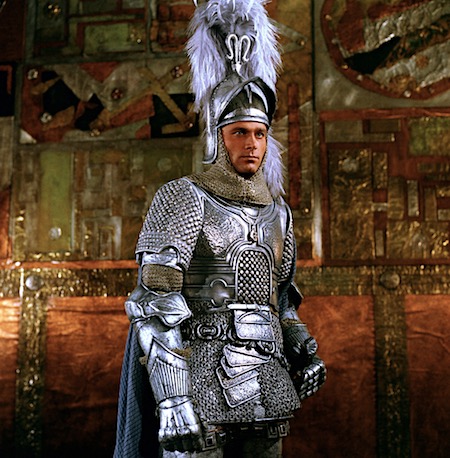
Coate: Is Camelot significant in any way?
Kennedy: Camelot is significant in several ways. It represents the first big budget musical produced for the screen after the quick succession of blockbusters Mary Poppins, My Fair Lady, and The Sound of Music convinced Hollywood that musicals were hot commodities and guaranteed money makers. Camelot disabused Hollywood of that notion, and became a red flag as other studios had already committed enormous resources to other expensive musicals.
It’s one of the last in a long line of Broadway-to-Hollywood musical adaptations before the film musical genre went into a deep and protracted decline.
Camelot appeared when society and film were changing at head-spinning speed. It was dated before it premiered. It stands in graphic contrast to Cool Hand Luke, The Graduate, In Cold Blood, and Bonnie and Clyde, all released in 1967. It’s clear in retrospect that Camelot began the extinction process of old school Broadway musicals extravagantly transferred to the screen.
Coate: How does the film compare to the Lerner-Loewe stage production?
Kennedy: A number of major changes were made in adapting the 1960 Broadway production. The film went on location to Spain and opened up the stage version considerably. The sets and costumes are an extreme reimagining from the original’s more traditional approach to mythic royalty. Designer John Truscott went crazy with an early hippie aesthetic mixed with Hammer film darkness and Doctor Zhivago winter freeze as needed.
The film’s casting prioritized movie stardom over musical talent. The original Broadway cast starred Richard Burton, Julie Andrews, and Robert Goulet. Two out of three were highly trained singers, with Burton perfecting the talk-singing technique that worked so well for Rex Harrison in the stage and screen version of Lerner and Loewe’s My Fair Lady. For Camelot, neither Richard Harris as Arthur, nor Vanessa Redgrave as Guenevere, nor Franco Nero as Lancelot were musically accomplished. Harris had a short-lived recording career after Camelot, but he’s most remembered as an actor.
Coate: Which are the standout songs in Camelot?
Kennedy: The score is probably the film’s strongest asset, boosted by lush orchestral arrangements. The Prelude and Overture are stirring on the big screen as they promise a grandiose entertainment. The aching love songs If Ever I Would Leave You and I Loved You Once in Silence are effective, and Guenevere has a cinematic urgency to it as it builds dramatic tension. C’est Moi gives background to Lancelot’s outsized ego, which sets up his audacious seduction of the queen. But the sentiments in other songs don’t age well. What Do the Simple Folk Do? offer condescending suppositions by the 1% (to borrow contemporary argot) on how everybody else lives. The lyrics of Then You May Take Me to the Fair, despite the benign title, are just plain gruesome.
 Coate: In what way was Richard Harris a memorable or effective King Arthur?
Coate: In what way was Richard Harris a memorable or effective King Arthur?
Kennedy: Richard Harris brought a well-suited regality to King Arthur. There’s a quality of inner strength to him that comes over well. He talk-sings in the manner of Rex Harrison and Richard Burton in the original stage version, though with more commitment to melody. These men had impeccable diction and wonderful mellifluous tones, so they could get away with speaking through their songs rather than hitting the notes. Harris’ acting is uneven, though, at times evoking a sibilant Marlon Brando in close-up.
Coate: In what way was Vanessa Redgrave a memorable or effective Guenevere?
Kennedy: Redgrave’s acting is exquisite, especially with Nero. She captures Guenevere’s romantic and erotic conflicts beautifully. Her sex appeal was a priority in casting her over Julie Andrews, who was too busy to film Camelot anyway. But Redgrave comes up short vocally. Her voice isn’t bad, but it lacks the training and support necessary to convey the powerful and diverse emotions going on with her character.
Coate: In what way was Joshua Logan an ideal choice to direct the film version of Camelot, and where does the film rank among his body of work?
Kennedy: Logan would seem to be a strong, if not an ideal, choice for Camelot. He directed Annie Get Your Gun, South Pacific, and Fanny on Broadway, then transferred the latter two to screen. He enjoyed success in Hollywood directing Picnic, Bus Stop, and Sayonara, but he goes badly astray with Camelot. This was Jack Warner’s swan song, and he threw an enormous $12 million at it. Logan didn’t know what to do with all that money. His prolific close-ups grow annoying over the too-long three-hour running time. The Round Table, despite a huge and expensive build set, is a giant anti-climax. I find Picnic, Bus Stop, Sayonara, and Fanny all more re-watchable than Camelot. Two years after Camelot, Paramount released the Logan directed musical Paint Your Wagon, famously starring a singing Clint Eastwood. It is a great big hot mess of a movie, more chaotic and boisterous than Camelot.
Coate: Where do you think Camelot ranks among 1960s era roadshow musicals?
Kennedy: As I explored in my book Roadshow! The Fall of Film Musicals in the 1960s, that era saw the exhaustion of big budget limited opening reserved-seat musical film extravaganzas. Financially, Camelot was a failure. Variety reported a $12.3 million [rental] on its initial run. That’s a respectable sum for the time, and would have been profitable had expenses been anywhere near the 1967 average. Doctor Dolittle, Star!, Paint Your Wagon, Goodbye, Mr. Chips, and Darling Lili were bigger flops. Far more successful than Camelot were West Side Story, My Fair Lady, The Sound of Music, Thoroughly Modern Millie, Oliver! and Funny Girl. Artistically, I’d put Camelot where it sits financially. It’s more meritorious than the other box office disappointments, but hardly equal to the most acclaimed and popular musical titles of the decade.
Coate: What is the legacy of Camelot?
Kennedy: Camelot endures as a prime example of a once viable but now obsolete filmmaking and marketing strategy. It’s a stunning reminder of how much has changed, both in the film industry and in society. There’s a pleasure in seeing so much opulence on the screen and realizing it was made by sweat, lumber, and paint, and not in someone’s software program. That commitment to grand picture making doesn’t exist anymore. It’s hard to imagine a straight-faced remake of Camelot these days — Monty Python’s Spamalot took care of that. In a way, the legacy of Camelot is that there is no legacy. There’s no obvious through-line from it to 21st century film musicals. It’s the near end of something, not the beginning.
Coate: Thank you, Matthew, for sharing your thoughts about Camelot on the occasion of its 50th anniversary.
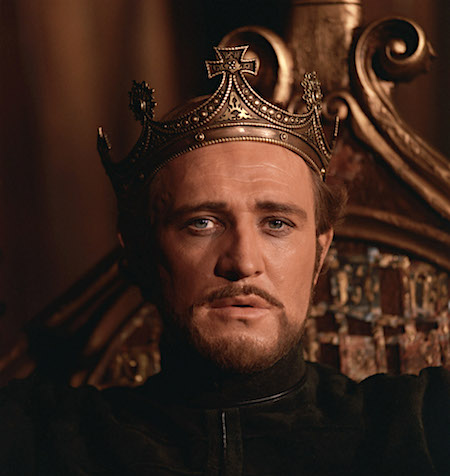
IMAGES
Selected images copyright/courtesy Robert Morrow collection, Warner Bros.-Seven Arts, Warner Bros. Pictures, Warner Home Video.
SPECIAL THANKS
Jim Barg, Raymond Caple, Thomas Hauerslev, Matthew Kennedy, Bill Kretzel, Ronald A. Lee, Mark Lensenmayer, Stan Malone, Robert Morrow, Jim Perry, Joel Weide, Vince Young, and an extra special thank-you to all of the librarians who helped with this project.
SOURCES/REFERENCES
The primary references for this project were regional newspaper coverage and trade reports published in Boxoffice, The Hollywood Reporter and Variety. All figures and data included in this article pertain to the United States and Canada except where stated otherwise.
- Michael Coate
Michael Coate can be reached via e-mail through this link. (You can also follow Michael on social media at these links: Twitter and Facebook)


